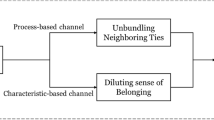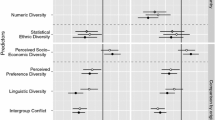Abstract
Community psychologists are interested in creating contexts that promote both respect for diversity and sense of community. However, recent theoretical and empirical work has uncovered a community-diversity dialectic wherein the contextual conditions that foster respect for diversity often run in opposition to those that foster sense of community. More specifically, within neighborhoods, residential integration provides opportunities for intergroup contact that are necessary to promote respect for diversity but may prevent the formation of dense interpersonal networks that are necessary to promote sense of community. Using agent-based modeling to simulate neighborhoods and neighborhood social network formation, we explore whether the community-diversity dialectic emerges from two principles of relationship formation: homophily and proximity. The model suggests that when people form relationships with similar and nearby others, the contexts that offer opportunities to develop a respect for diversity are different from the contexts that foster a sense of community. Based on these results, we conclude with a discussion of whether it is possible to create neighborhoods that simultaneously foster respect for diversity and sense of community.





Similar content being viewed by others
Notes
Values greater than 50 % are conceptually possible and describe what is known as dissortative mixing, where a person is surrounded primarily by dissimilar others. In a neighborhood context, this might occur for one or two households (e.g. a single minority household in a majority neighborhood). However, it can occur neighborhood-wide only if minority and majority households are arranged in a very precise “stripe” pattern, which guarantees that any given household has a maximum of only two similar neighbors (i.e. one in one direction, and another in the opposite direction). Such an arrangement is does not seem realistic, so we have excluded it from our simulations. This exclusion does not affect our results, which we find remain the same even if we had also simulated such unrealistic hyper-integrated neighborhoods.
The only widespread example of heterophily, the opposite of homophily wherein relationships are more likely between dissimilar people, is along gender lines in the formation of romantic and sexual relationships among heterosexual individuals: heterosexual men form relationships primarily with women, and not with other men, and vice versa.
References
Allport, G. W. (1954). The nature of prejudice. Cambridge, MA: Perseus Books.
Amir, Y. (1969). Contact hypothesis in ethnic relations. Psychological Bulletin, 71(5), 319–342.
Berryhill, J. C., & Linney, J. A. (2006). On the edge of diversity: Bringing African Americans and Latinos together in a neighborhood group. American Journal of Community Psychology, 37(3/4), 247–255. doi:10.1007/s10464-006-9012-0.
Blau, P. M. (1977). A macrosociological theory of social structure. American Journal of Sociology, 83(1), 26–54.
Box, G. E. P. (1976). Science and statistics. Journal of the American Statistical Association, 71(356), 791–799.
Burt, R. S. (2001). Structural holes versus network closure as social capital. In N. Lin & R. S. Burt (Eds.), Social capital: Theory and research (pp. 31–56). New York: Aldine de Gruyter.
Chavis, D. M., & Pretty, G. M. H. (1999). Sense of community: Advances in measurement and application. Journal of Community Psychology, 27(6), 635–642.
Coleman, J. S. (1988). Social capital in the creation of human capital. American Journal of Sociology, 94(S), S95–S120.
Crenshaw, K. (1991). Mapping the margins: Intersectionality, identity politics, and violence against women of color. Stanford Law Review, 43(6), 1241–1299.
Dixon, J., Durrheim, K., & Tredoux, C. (2005). Beyond the optimal contact strategy: A reality check for the contact hypothesis. American Psychologist, 60(7), 697–711.
Festinger, L., Schachter, S., & Back, K. (1950). Social pressures in informal groups: A Study of Human Factors in Housing. New York: Harper & Brothers.
Florida, R. (2002). The rise of the creative class: And how it’s transforming work, leisure, community, and everyday life. New York: Basic Books.
Fu, F., Nowak, M. A., Christakis, N. A., & Fowler, J. H. (2012). The evolution of homophily. Scientific Reports, 2, 845.
Grannis, R. (2009). From the ground up: Translating geography into community through neighbor networks. Princeton, NJ: Princeton University Press.
Granovetter, M. S. (1973). The strength of weak ties. American Journal of Sociology, 78(6), 1360–1380.
Harrell, S., & Bond, M. A. (2006). Listening to diversity stories: Principles for practice in community research and action. American Journal of Community Psychology, 37, 365–376.
Hewstone, M., & Brown, R. (Eds.). (1986). Contact and conflict in intergroup encounters: Social psychology and society. Cambridge, MA: Basil Blackwell.
Hill, J. L. (1996). Psychological sense of community: Suggestions for future research. Journal of Community Psychology, 24(4), 431–438.
Hoffer, L. D., Bobashev, G., & Morris, R. J. (2009). Researching a local heroine market as a complex adaptive system. American Journal of Community Psychology, 44, 273–286.
Kelly, J. G. (1971). Qualities for the community psychologist. American Psychologist, 26, 897–903.
Lazarsfeld, P. F., & Merton, R. K. (1964). Friendship as a social process: A substantive and methodological analysis. In M. Berger, T. Abel, & C. H. Page (Eds.), Freedom and control in modern society (pp. 18–66). New York: Octagon Books.
Lenzi, M., Vieno, A., Santinello, M., & Perkins, D. D. (2013). How neighborhood structural and institutional features can shape neighborhood social connections: A multilevel study of adolescent perceptions. American Journal of Community Psychology, 51, 451–467.
Lindblad, M. R., Manturuk, K. R., & Quercia, R. G. (2013). Sense of community and informal social control among lower income households: The role of homeownership and collective efficacy in reducing subjective neighborhood crime and disorder. American Journal of Community Psychology, 51, 123–139.
Long, D. A., & Perkins, D. D. (2003). Confirmatory factor analysis of the sense of community index and development of a brief SCI. Journal of Community Psychology, 31(3), 279–296.
Macy, M. W., & Willer, R. (2002). From factors to actors: Computational sociology and agent-based models. Annual Review of Sociology, 28, 143–166.
McMillian, D. W., & Chavis, D. M. (1986). Sense of community: A definition and theory. Journal of Community Psychology, 14, 6–23.
McPherson, M., Smith-Lovin, L., & Cook, J. M. (2001). Birds of a feather: Homophily in social networks. Annual Review of Sociology, 27, 415–444.
Moreno, J. L. (1934). Who shall survive? A new approach to the problem of human interrelations. Washington, DC: Nervous and Mental Disease Publishing Co.
Peterson, N. A., Speer, P. W., & McMillian, D. W. (2008). Validation of a brief sense of community scale: Confirmation of the principal theory of sense of community. Journal of Community Psychology, 36, 61–73.
Portes, A. (1998). Social capital: Its origins and applications in modern sociology. Annual Review of Sociology, 24, 1–24.
Portes, A., & Vickstrom, E. (2011). Diversity, social capital, and cohesion. Annual Review of Sociology, 37, 461–479. doi:10.1146/annurev-soc-081309-150022.
Prilleltensky, I. (2001). Value-based praxis in community psychology: Moving toward social justice and social action. American Journal of Community Psychology, 29, 747–778.
Putnam, R. D. (2001). Bowling alone: the collapse and revival of American community. New York: Simon & Schuster.
Putnam, R. D. (2007). E Pluribus Unum: diversity and community in the twenty-first century. Scandinavian Political Studies, 30, 137–174.
Rappaport, J. (1977). Community psychology: Values, research, and action. New York: Holt, Rinehart, & Winston.
Rappaport, J. (1981). In praise of paradox: A social policy of empowerment over prevention. American Journal of Community Psychology, 9, 1–25.
Riger, S. (1993). What’s wrong with empowerment. American Journal of Community Psychology, 21(3), 279–292.
Ryan, W. (1976). Blaming the victim. New York: Random House.
Sarason, S. B. (1974). The psychological sense of community: Prospects for a community psychology. San Francisco, CA: Jossey-Bass.
Schelling, T. (1969). Models of segregation. American Economic Review, 59(2), 488–493.
Shook, N. J., & Fazio, R. H. (2008). Interracial roommate relationships: An experimental field test of the contact hypothesis. Psychological Science, 19(7), 717–723.
Sigelman, L., & Welch, S. (1993). The contact hypothesis revisited: Black-white interaction and positive racial attitudes. Social Forces, 71(3), 781–795.
Society for Community Research and Action. (2010). Policies and procedures manual. Retrieved from: http://www.scra27.org/documents/scradocume/policiesandproceduresmanualrevisedjuly2010pdf.
Townley, G., Kloos, B., Green, E. P., & Franco, M. M. (2011). Reconcilable differences? Human diversity, cultural relativity, and sense of community. American Journal of Community Psychology, 47, 69–85. doi:10.1007/s10464-010-9379-9.
Trickett, E. J., Watts, R. J., & Birman, D. (1994). Toward an overarching framework for diversity. In E. J. Trickett, R. J. Watts, & D. Birman (Eds.), Human diversity: Perspectives on people in context (pp. 7–26). San Francisco: Jossey Bass.
Watts, D. J., & Strogatz, S. H. (1998). Collective dynamics of small-world networks. Nature, 393, 440–442.
Wilensky, U. (1999). NetLogo. Center for connected learning and computer-based modeling. Evanston, IL: Northwestern University.
Acknowledgments
The authors wish to thank the staff at the High Performance Computing Center at Michigan State University for their technical assistance.
Author information
Authors and Affiliations
Corresponding author
Electronic supplementary material
Below is the link to the electronic supplementary material.
Rights and permissions
About this article
Cite this article
Neal, Z.P., Neal, J.W. The (In)compatibility of Diversity and Sense of Community. Am J Community Psychol 53, 1–12 (2014). https://doi.org/10.1007/s10464-013-9608-0
Published:
Issue Date:
DOI: https://doi.org/10.1007/s10464-013-9608-0




